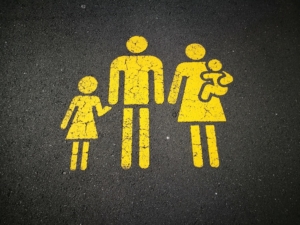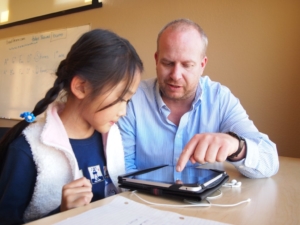Christian Family Counseling: Finding Help When Your Family Needs It
Time spent with family can be stressful. For many people, the holidays and time spent at home are a difficult period because being with their relatives, the family that they were born into, can for whatever reason be overwhelming and taxing. Whether it’s the conversations or something amiss in the family dynamic, what is meant to be a time of relaxation and celebration becomes a chore at the best of times.
 Family is meant to be an institution for nurture, growth, joy, and flourishing. When we go through tragedy, or when we’re celebrating, our family is one space where we should feel encouraged and supported. The gap between what is and what ought to be is often a yawning chasm.
Family is meant to be an institution for nurture, growth, joy, and flourishing. When we go through tragedy, or when we’re celebrating, our family is one space where we should feel encouraged and supported. The gap between what is and what ought to be is often a yawning chasm.
What can families do about this reality? Some have chosen to ignore the issues, and they power through the awkwardness and pain. Other families have floundered under the strain. One avenue of aid is to seek Christian family counseling from a Licensed Marriage and Family Therapist, such as Newport Beach Christian Counseling.
God has a plan for families, whatever the shape of yours may be. Getting help in the form of Christian family counseling can make the difference between a family struggling and limping along, and a healthy, supportive, and nurturing family environment.
Christian Family Counseling: What’s That?
Christian family counseling is a form of counseling that looks to address the family as a unit to bring about flourishing for both individuals in the family and the family as a whole. Individual counseling, on the other hand, is primarily focused on addressing the concerns of the individual.
Christian family counseling addresses the family or individuals within it as is proper. Often, when one member of the family is going through something, it affects the others. If one of the children is having difficulties at school, it can affect how they interact with their siblings.
If one of the parents is facing mental health challenges or is dealing with grief, it will affect how they relate to their spouse and the family too. Family counseling recognizes this interconnectedness within the family, and the therapeutic techniques take that reality into account.
Does My Family Need Counseling?
Whether you and your family require counseling is something you must decide for yourselves. If you’re feeling overwhelmed, facing challenges for which you feel ill-equipped, or maybe you’re just feeling stuck, you can turn to Christian family counseling for help.
 You don’t have to be a Christian to receive help from Christian family counseling, though the approach and emphases of the therapy will address spirituality as an important part of the whole. A Christian therapist will help you and your family identify behaviors that may be inconsistent with what God’s word says and that may be hindering your growth.
You don’t have to be a Christian to receive help from Christian family counseling, though the approach and emphases of the therapy will address spirituality as an important part of the whole. A Christian therapist will help you and your family identify behaviors that may be inconsistent with what God’s word says and that may be hindering your growth.
Christian family therapists are trained and licensed in the same way as other therapists who have training in psychology and understand the complexity of human relationships. One major difference is that a Christian therapist is also guided by Scripture and prayer, combined with their training in psychology. They help you address issues in your family life that are taking away from what God intends for his people.
Christian family therapists deal with a wide variety of issues. The issues they deal with include mental health challenges and relational dynamics within the family. They teach coping skills and tools to communicate more effectively so that the family can deal with changes and challenges in a healthy way. Here are some of the areas in which you can get help from a Christian family therapist:
Encouraging and strengthening your faith and relationship with God.
There are many challenges in living faithfully and connected with God. Sometimes work pressures, school, adolescence, or peer pressure and so much more can complicate or undermine one’s relationship with God. It might be that one of the family members is struggling with their faith, or that as a family you’ve been through a crisis that has rattled your faith.
Address trauma and abuse.
Living as we do in an imperfect world, we and our families may experience trauma and abuse. Trauma may occur through an event like a car accident, being mugged, experiencing a natural disaster, etc. Emotional or physical abuse can have a huge effect on mental health, and they need to be addressed in a safe environment
Social media addiction.
With easy and constant access to the internet, we can lose ourselves and our families to cyberspace; people can spend more time online than they do with their families, and they can become more invested in what happens online than what happens in their own home.
Help address marital issues.
Marriages face many challenges, and Christian family therapy can help you to work to avoid divorce, address infidelity, strengthen your emotional and physical intimacy, improve poor communication, etc.
 Dealing with grief and loss.
Dealing with grief and loss.
Losing a loved one when they die or experiencing other losses such as divorce or relocation and leaving familiar people and places may take an emotional toll. Therapy can create the space you need to process those emotions.
Pornography addiction.
Porn addiction affects men, women, and children. It can damage relationships and produce distorted views of sex and sexuality, which can devastate your marriage, and negatively affect both work and school performance.
Substance abuse and addiction.
Addictions can end up ruling a person’s life, dictating their choices, breaking relationships and trust. Therapy can help not only with uncovering underlying issues that may be driving addictive behaviors but providing ways to overcome addiction and begin making healthy life choices
Parenting difficulties.
Children face a wide variety of challenges, and parents desire to help their children work through those difficulties. You may be dealing with a willful child, or other challenges such a mental health issues, learning disabilities, bullying, eating disorders, and so on. Therapy will not only inform your understanding of the issues but provide you with the tools you need to support one another.
A Christian family counselor can address these and many other concerns you may have and be dealing with. If your family life is affected by anyone or several of these issues, seeking the help of a therapist may be the best next step to take for your family’s sake.
Getting the Help You Need
 If you decide to seek help, you need to find a counselor that works for you and your family. The first obstacle to overcome, however, is that sometimes people hesitate to find help because of feelings of shame or a sense of failure. We all have different struggles, and when you reach your limit, the best thing you can do for your family is to take that courageous first step and ask for help.
If you decide to seek help, you need to find a counselor that works for you and your family. The first obstacle to overcome, however, is that sometimes people hesitate to find help because of feelings of shame or a sense of failure. We all have different struggles, and when you reach your limit, the best thing you can do for your family is to take that courageous first step and ask for help.
If you’re looking for a therapist, you can find licensed and trained Christian marriage and family therapists at your local church, and they also have independent practices in medical centers and elsewhere. Alternatively, a family member, friend, or spiritual advisor that you trust can refer you to a therapist.
If you don’t want to go into a brick-and-mortar office for your sessions, doing your sessions via online therapy is a possibility. The online option is attractive if you find a therapist you want to work with, but they are a long drive away or you can’t coordinate your schedule to attend in person, or if you have privacy concerns.
Another key point in finding a therapist that works for you is to check that their beliefs and approach align with yours, otherwise it may not work for you. Your relationship with your therapist is key to success in counseling and debating the meaning of certain passages of the Bible instead of getting on with the work may be an obstacle.
Because Christian therapists use a broad range of tools including evidence-based counseling methods like Cognitive Behavioral Therapy (CBT), prayer, and Scripture, they address the whole person, including your spiritual needs.
When you’ve chosen the therapist you and your family want to work with, they’ll get a feel for what your needs are, work with you to set your goals, and set out steps to achieve them. Newport Beach Christian Counseling can guide you in taking that first step towards wholeness and finding a therapist who can help your family discover the peace, joy, and flourishing you yearn for.
“Tough Times”, Courtesy of Ben White, Unsplash.com; CC0 License; “Family”, Courtesy of John-Mark Smith, Unsplash.com, CC0 License;”Reading Together”, Courtesy of Ben White, Unsplash.com, CC0 License; “Difficult roads…beautiful destinations”, Courtesy of Hello I’m Nik, Unsplash.com, CC0 License

 God has not left us alone in this. The Bible gives us wisdom on how to navigate this important area of life, challenging and encouraging us to enter and conduct relationships in a healthy manner. Below are a few key verses with wisdom on handling and thinking about relationships in a life-giving way.
God has not left us alone in this. The Bible gives us wisdom on how to navigate this important area of life, challenging and encouraging us to enter and conduct relationships in a healthy manner. Below are a few key verses with wisdom on handling and thinking about relationships in a life-giving way. knows God. Whoever does not love does not know God, because God is love… If anyone says, “I love God,” yet hates his brother, he is a liar. For anyone who does not love his brother, whom he has seen, cannot love God, whom he has not seen.” (1 John 4:7-8, 20).
knows God. Whoever does not love does not know God, because God is love… If anyone says, “I love God,” yet hates his brother, he is a liar. For anyone who does not love his brother, whom he has seen, cannot love God, whom he has not seen.” (1 John 4:7-8, 20). The earlier verse mentioned getting rid of anger. Anger is a real issue for many. While anger is a valid emotional reaction to circumstances or certain actions by people, it can become crippling if we live in it. Anger can fester and take root so deep that even being in the same room with the person becomes impossible.
The earlier verse mentioned getting rid of anger. Anger is a real issue for many. While anger is a valid emotional reaction to circumstances or certain actions by people, it can become crippling if we live in it. Anger can fester and take root so deep that even being in the same room with the person becomes impossible. God has placed us in many different communities, including the community of faith. To live out the Christian life, we need that community. The reciprocal pronoun “one another” is prominent in the New Testament: “Live in harmony with one another” (Romans 12:16); “Be servants of one another’ (Galatians 5:13); “Comfort one another” (1 Thess. 5:11); “Submit to one another” (Eph. 5:21); “Forgive one another” (Col. 3:13); “Confess your sins to one another” (James 5:16); “Love one another from the heart” (1 Pet. 1:22) and so many more.
God has placed us in many different communities, including the community of faith. To live out the Christian life, we need that community. The reciprocal pronoun “one another” is prominent in the New Testament: “Live in harmony with one another” (Romans 12:16); “Be servants of one another’ (Galatians 5:13); “Comfort one another” (1 Thess. 5:11); “Submit to one another” (Eph. 5:21); “Forgive one another” (Col. 3:13); “Confess your sins to one another” (James 5:16); “Love one another from the heart” (1 Pet. 1:22) and so many more. Families may need to address overarching issues of grief, anger, stress, or poor communication skills. It is definitive that all families will face obstacles of various kinds; however, it is important to note that your family does not have to deal with these roadblocks without the support and guidance of a counselor who can aid you in your family’s journey.
Families may need to address overarching issues of grief, anger, stress, or poor communication skills. It is definitive that all families will face obstacles of various kinds; however, it is important to note that your family does not have to deal with these roadblocks without the support and guidance of a counselor who can aid you in your family’s journey. They need a safety net, a place of trust, a place to ease anxiety and make their feelings known. Children need a place to ask questions because the world will fill their minds with many thoughts and feelings that they are unsure how to process. Adults need communication with their spouse where they can make their feelings of depression or anxiety known without feeling like a failure.
They need a safety net, a place of trust, a place to ease anxiety and make their feelings known. Children need a place to ask questions because the world will fill their minds with many thoughts and feelings that they are unsure how to process. Adults need communication with their spouse where they can make their feelings of depression or anxiety known without feeling like a failure. If one person in the family is struggling, it impacts family dynamics and likely means that the entire family is functioning differently. Most of the time, we do not struggle during the initial spiral of emotions and crisis, but afterward when the initial wave of support has come and gone.
If one person in the family is struggling, it impacts family dynamics and likely means that the entire family is functioning differently. Most of the time, we do not struggle during the initial spiral of emotions and crisis, but afterward when the initial wave of support has come and gone. Today, you can begin your family’s journey to health by:
Today, you can begin your family’s journey to health by: But in those times, it was quite clear that such devices were generally for entertainment purposes. It was easier then for both parents and children to understand that when studying or doing other daily tasks, such devices had to be turned off or left at home.
But in those times, it was quite clear that such devices were generally for entertainment purposes. It was easier then for both parents and children to understand that when studying or doing other daily tasks, such devices had to be turned off or left at home. For lots of teens, their social media accounts have become their virtual “hangout” where they keep in touch with others, even if they are at home. Teens can easily spend hours on their various accounts as they scroll through their friends’ and family members’ accounts, communicate with others, and update their own social media pages. And this is where the anxiety comes in.
For lots of teens, their social media accounts have become their virtual “hangout” where they keep in touch with others, even if they are at home. Teens can easily spend hours on their various accounts as they scroll through their friends’ and family members’ accounts, communicate with others, and update their own social media pages. And this is where the anxiety comes in.
 When being mindful, the brain is trained to become aware of the things happening around them – sounds of water or animal life, the feel of the ground under their feet, the smell of their immediate environment, or the beauty of their world seen through open eyes. In this way, they may then be able to pull their minds out of the virtual world they may be in and reassess what is “real.” This is particularly helpful if they find their minds stuck on negative thoughts about a recent post or comment on social media.
When being mindful, the brain is trained to become aware of the things happening around them – sounds of water or animal life, the feel of the ground under their feet, the smell of their immediate environment, or the beauty of their world seen through open eyes. In this way, they may then be able to pull their minds out of the virtual world they may be in and reassess what is “real.” This is particularly helpful if they find their minds stuck on negative thoughts about a recent post or comment on social media. Though this stage of life may be a distant memory for you personally, it is important to be empathetic to your kids as they navigate through this often confusing and emotionally-charged period of their lives and face some of the common challenges of teenagers.
Though this stage of life may be a distant memory for you personally, it is important to be empathetic to your kids as they navigate through this often confusing and emotionally-charged period of their lives and face some of the common challenges of teenagers. In addition, social media perpetuates another unpleasant issue — cyber bullying. With private messages open, and with anyone open to comment on your appearance, bullying is a common and corrosive issue among this age group.
In addition, social media perpetuates another unpleasant issue — cyber bullying. With private messages open, and with anyone open to comment on your appearance, bullying is a common and corrosive issue among this age group. The adolescent years can be extremely confusing, as you are met with deep questions over purpose and identity. What are you going to do after finishing school? Who are the friends that will stick by you? What is the true meaning of your life?
The adolescent years can be extremely confusing, as you are met with deep questions over purpose and identity. What are you going to do after finishing school? Who are the friends that will stick by you? What is the true meaning of your life? messaging.
messaging. Many people claim that they are “aware” about the use of therapy for mental illnesses. In fact, on both the big and small screens, characters are often shown visiting a therapist to assist them with their mental or emotional issues.
Many people claim that they are “aware” about the use of therapy for mental illnesses. In fact, on both the big and small screens, characters are often shown visiting a therapist to assist them with their mental or emotional issues. Therapy, however, is meant to be a venue where a person CAN share these inner thoughts, fears, and desires without being judged, ridiculed, or exposed. Professional therapists know this and approach each situation with an open mind, giving unbiased advice on what to do. As they are not personally involved, it is sometimes even easier for them to notice things that family members and friends cannot see; or share the advice that loved ones with vested interests do not want to say.
Therapy, however, is meant to be a venue where a person CAN share these inner thoughts, fears, and desires without being judged, ridiculed, or exposed. Professional therapists know this and approach each situation with an open mind, giving unbiased advice on what to do. As they are not personally involved, it is sometimes even easier for them to notice things that family members and friends cannot see; or share the advice that loved ones with vested interests do not want to say. Unlike other physical ailments, there is no single solution to each mental health problem. Every client’s background and personality have to be taken into consideration before the right steps can be made. This is why it is important that both the client and therapist are able to work well with one another.
Unlike other physical ailments, there is no single solution to each mental health problem. Every client’s background and personality have to be taken into consideration before the right steps can be made. This is why it is important that both the client and therapist are able to work well with one another. The brokenness of life affects everyone, including children. But since children’s brains aren’t fully developed, sometimes we struggle to help them cope with difficulty or trauma. If you have a toolbox of techniques and activities for children, you can consider which one(s) might help an individual child in their situation.
The brokenness of life affects everyone, including children. But since children’s brains aren’t fully developed, sometimes we struggle to help them cope with difficulty or trauma. If you have a toolbox of techniques and activities for children, you can consider which one(s) might help an individual child in their situation. What is one thing you would like to teach someone else?
What is one thing you would like to teach someone else?
 Do you ever feel completely overwhelmed and exhausted, like you just want to check out of life?
Do you ever feel completely overwhelmed and exhausted, like you just want to check out of life? People may use the term “OCD” in an almost light-hearted manner to justify behaviors or rules which they themselves practice. But for anyone diagnosed with real Obsessive Compulsive Disorder (OCD), there is nothing light-hearted about their struggles. For them, the condition often brings distress and places limits on their every day lives to varying degrees.
People may use the term “OCD” in an almost light-hearted manner to justify behaviors or rules which they themselves practice. But for anyone diagnosed with real Obsessive Compulsive Disorder (OCD), there is nothing light-hearted about their struggles. For them, the condition often brings distress and places limits on their every day lives to varying degrees. The obsessions and compulsions are often connected, such as germophobia and washing one’s hands. Or, a student is so afraid of failing that he or she keeps on checking and checking his or her test answers even to the point of missing recess or lunch.
The obsessions and compulsions are often connected, such as germophobia and washing one’s hands. Or, a student is so afraid of failing that he or she keeps on checking and checking his or her test answers even to the point of missing recess or lunch.
 Teach your child to recognize their obsessions and compulsions. Knowledge is a power.
Teach your child to recognize their obsessions and compulsions. Knowledge is a power. By reading this article you’re taking the first step in what can be a journey of healing and hope. We’ll discuss different types of family counselors, how to select one who’s right for you, and how to budget for counseling. Take the time to consider each point in the selection process, and you’ll be equipped to make an informed decision.
By reading this article you’re taking the first step in what can be a journey of healing and hope. We’ll discuss different types of family counselors, how to select one who’s right for you, and how to budget for counseling. Take the time to consider each point in the selection process, and you’ll be equipped to make an informed decision. Behavior intervention applies to children who are struggling with problem behaviors, or to adults who are behaving inappropriately either in public or at home. In the family therapy setting, parents and the child will work with the counselor to identify unacceptable behaviors, set boundaries, and create rewards systems, along with other helpful skills.
Behavior intervention applies to children who are struggling with problem behaviors, or to adults who are behaving inappropriately either in public or at home. In the family therapy setting, parents and the child will work with the counselor to identify unacceptable behaviors, set boundaries, and create rewards systems, along with other helpful skills. Children going through puberty or experiencing life stress or mental health issues may struggle to have a good relationship with their parents. They may exhibit disrespect and dislike. Parents also deal with life stressors, mental health issues, and other factors that can make positive parenting difficult.
Children going through puberty or experiencing life stress or mental health issues may struggle to have a good relationship with their parents. They may exhibit disrespect and dislike. Parents also deal with life stressors, mental health issues, and other factors that can make positive parenting difficult. First, consider the value you place on therapy and the perspective that it can preventative medicine for your family relationships. Yes, therapy is expensive, but as counselors, we truly believe it’s worth it.
First, consider the value you place on therapy and the perspective that it can preventative medicine for your family relationships. Yes, therapy is expensive, but as counselors, we truly believe it’s worth it. In addition, children may be able to exert more control over their behavior in some kinds of circumstances rather than in others, particularly when emotions are running high. While parents find this understandably exasperating, it is normal.
In addition, children may be able to exert more control over their behavior in some kinds of circumstances rather than in others, particularly when emotions are running high. While parents find this understandably exasperating, it is normal. There may be various explanations for why a child steals. It may be that the act of stealing is exhilarating to a child, or perhaps because it enables them to somehow feel in control. It is important to question a child’s motivation to get to the bottom of the behavior.
There may be various explanations for why a child steals. It may be that the act of stealing is exhilarating to a child, or perhaps because it enables them to somehow feel in control. It is important to question a child’s motivation to get to the bottom of the behavior. The child may have an active imagination and find it hard to stay present, getting lost in their imaginings. If ADHD is the cause of the problem of ignoring others, it is possible for children to be taught ways of managing their difficulties with concentration.
The child may have an active imagination and find it hard to stay present, getting lost in their imaginings. If ADHD is the cause of the problem of ignoring others, it is possible for children to be taught ways of managing their difficulties with concentration. It is important to uncover the underlying reasons why a child feels the need to use substances – for example, is it as a means of coping? Or is it because of peer pressure from friends?
It is important to uncover the underlying reasons why a child feels the need to use substances – for example, is it as a means of coping? Or is it because of peer pressure from friends?